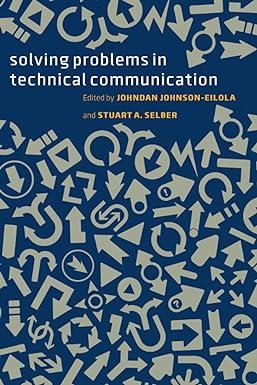Answered step by step
Verified Expert Solution
Question
1 Approved Answer
You have a 6-year-old bilingual second language learner on your caseload who has an IEP. He was diagnosed as speech/language impaired by a previous therapist,
You have a 6-year-old bilingual second language learner on your caseload who has an IEP. He
was diagnosed as speech/language impaired by a previous therapist, and has goals to work on:
increasing vocabulary, speaking in complete sentences to communicate more effectively and
improve various aspects of syntax. You have been working with this student for about 4 months,
and you are not sure if he has a language disorder, but suspect it could possibly be a language
difference.
Using the information from your textbook, handouts, class notes and assigned readings, address
the following:
Describe at least three different types of dynamic assessment
How could you use dynamic assessment to determine if it is a language disorder or
language difference?
Describe specific dynamic assessment procedures for each of the areas of weakness as
indicated by the goals on his IEP.
o For each task, describe how you would use the results to support a diagnosis of
language disorder vs language difference. In other words, what specific behaviors
would help you to determine the diagnosis?
To receive full credit, you must reference information from your textbook, handouts and the
following three supplemental readings from our course Canvas site. However, DO NOT copy
information directly from the book or readings. Use your own words, but indicate the source of
the information/idea.
Kapantzoglou, M., Restrepo, A. & Thompson, M.S. (2013). Dynamic Assessment of Word
Learning Skills: Identifying Language Impairment in Bilingual Children. Language, Speech and
Hearing Services in the Schools. 34, 81-96.
Gutierrez-Clellen, V.F. and Pena, E. (2001). Dynamic Assessment of diverse children: A
Tutorial. Language, Speech and Hearing Services in the Schools. 32, 212-224
Laing, S.P. & Kamhi, A. (2003). Alternative Assessment of Language
and Literacy in Culturally and Linguistically Diverse Populations. Language, Speech and
Hearing Services in the Schools. 34, 44-55
was diagnosed as speech/language impaired by a previous therapist, and has goals to work on:
increasing vocabulary, speaking in complete sentences to communicate more effectively and
improve various aspects of syntax. You have been working with this student for about 4 months,
and you are not sure if he has a language disorder, but suspect it could possibly be a language
difference.
Using the information from your textbook, handouts, class notes and assigned readings, address
the following:
Describe at least three different types of dynamic assessment
How could you use dynamic assessment to determine if it is a language disorder or
language difference?
Describe specific dynamic assessment procedures for each of the areas of weakness as
indicated by the goals on his IEP.
o For each task, describe how you would use the results to support a diagnosis of
language disorder vs language difference. In other words, what specific behaviors
would help you to determine the diagnosis?
To receive full credit, you must reference information from your textbook, handouts and the
following three supplemental readings from our course Canvas site. However, DO NOT copy
information directly from the book or readings. Use your own words, but indicate the source of
the information/idea.
Kapantzoglou, M., Restrepo, A. & Thompson, M.S. (2013). Dynamic Assessment of Word
Learning Skills: Identifying Language Impairment in Bilingual Children. Language, Speech and
Hearing Services in the Schools. 34, 81-96.
Gutierrez-Clellen, V.F. and Pena, E. (2001). Dynamic Assessment of diverse children: A
Tutorial. Language, Speech and Hearing Services in the Schools. 32, 212-224
Laing, S.P. & Kamhi, A. (2003). Alternative Assessment of Language
and Literacy in Culturally and Linguistically Diverse Populations. Language, Speech and
Hearing Services in the Schools. 34, 44-55
Step by Step Solution
★★★★★
3.39 Rating (152 Votes )
There are 3 Steps involved in it
Step: 1
Dynamic Assessment for a Bilingual Second Language Learner The situation you described highlights the importance of differentiating between a language disorder and a language difference in a bilingual ...
Get Instant Access to Expert-Tailored Solutions
See step-by-step solutions with expert insights and AI powered tools for academic success
Step: 2

Step: 3

Ace Your Homework with AI
Get the answers you need in no time with our AI-driven, step-by-step assistance
Get Started


